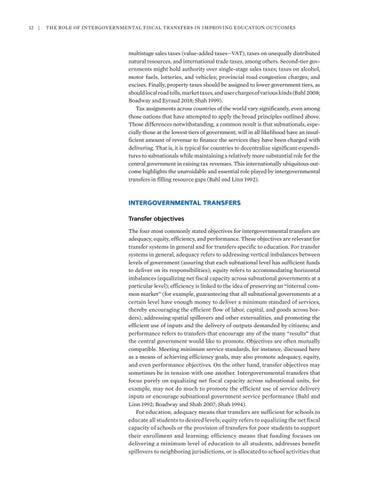12 | The Role of Intergovernmental Fiscal Transfers in Improving Education Outcomes
multistage sales taxes (value-added taxes—VAT), taxes on unequally distributed natural resources, and international trade taxes, among others. Second-tier governments might hold authority over single-stage sales taxes; taxes on alcohol, motor fuels, lotteries, and vehicles; provincial road congestion charges; and excises. Finally, property taxes should be assigned to lower government tiers, as should local road tolls, market taxes, and user charges of various kinds (Bahl 2008; Boadway and Eyraud 2018; Shah 1999). Tax assignments across countries of the world vary significantly, even among those nations that have attempted to apply the broad principles outlined above. Those differences notwithstanding, a common result is that subnationals, especially those at the lowest tiers of government, will in all likelihood have an insufficient amount of revenue to finance the services they have been charged with delivering. That is, it is typical for countries to decentralize significant expenditures to subnationals while maintaining a relatively more substantial role for the central government in raising tax revenues. This internationally ubiquitous outcome highlights the unavoidable and essential role played by intergovernmental transfers in filling resource gaps (Bahl and Linn 1992).
INTERGOVERNMENTAL TRANSFERS Transfer objectives The four most commonly stated objectives for intergovernmental transfers are adequacy, equity, efficiency, and performance. These objectives are relevant for transfer systems in general and for transfers specific to education. For transfer systems in general, adequacy refers to addressing vertical imbalances between levels of government (assuring that each subnational level has sufficient funds to deliver on its responsibilities); equity refers to accommodating horizontal imbalances (equalizing net fiscal capacity across subnational governments at a particular level); efficiency is linked to the idea of preserving an “internal common market” (for example, guaranteeing that all subnational governments at a certain level have enough money to deliver a minimum standard of services, thereby encouraging the efficient flow of labor, capital, and goods across borders), addressing spatial spillovers and other externalities, and promoting the efficient use of inputs and the delivery of outputs demanded by citizens; and performance refers to transfers that encourage any of the many “results” that the central government would like to promote. Objectives are often mutually compatible. Meeting minimum service standards, for instance, discussed here as a means of achieving efficiency goals, may also promote adequacy, equity, and even performance objectives. On the other hand, transfer objectives may sometimes be in tension with one another. Intergovernmental transfers that focus purely on equalizing net fiscal capacity across subnational units, for example, may not do much to promote the efficient use of service delivery inputs or encourage subnational government service performance (Bahl and Linn 1992; Boadway and Shah 2007; Shah 1994). For education, adequacy means that transfers are sufficient for schools to educate all students to desired levels; equity refers to equalizing the net fiscal capacity of schools or the provision of transfers for poor students to support their enrollment and learning; efficiency means that funding focuses on delivering a minimum level of education to all students, addresses benefit spillovers to neighboring jurisdictions, or is allocated to school activities that






